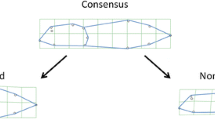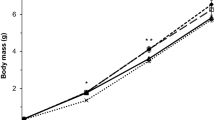Abstract
We investigated the role of constitutive morphology and previous experience in predator avoidance in two anuran species associated with different larval habitats. In Rana temporaria, deeper tails and larger body size conferred selective advantage against dragonfly predation. Previous experience with predators had a positive influence on the survival of R. temporaria tadpoles equivalent to predator selection. By contrast, survival in Bufo bufo seems unrelated to tail shape or experience. This suggests that B. bufo lacks constitutive morphological defenses against insect predators, and that morphological and behavioral defenses could result more effective than chemical deterrents for these insect predators. A key novelty of this study is the observation that Rana tadpoles having prior experience with predators have an enhanced success in further encounters, and this occurs before the morphological induced defense has been established. This induced modification for R. temporaria, and its lack of for B. bufo, may be an important determinant of larval survival.
Similar content being viewed by others
References
Agrawal AA, Karban R (1999) Why induced defenses may be favored over constitutive strategies in plants? In: Tollrian R, Harvell CD (eds) The ecology and evolution of inducible defenses. Princeton University Press, Princeton, pp 46–61
Allen JA (1988) Frequency-dependent selection by predators. Phil Trans R Soc Lond B 319:485–503
Arnold EN, Wassersug RJ (1978) Differential predation on metamorphic anurans by garter snakes (Thamnophis): social behaviour as possible defense. Ecology 59:1014–1022
Bookstein FL (1991) Morphometric tools for landmark data. Geometry and biology. Cambridge University Press, Cambridge
Brody AK, Karban R (1992) Lack of a tradeoff between constitutive and induced defenses among varieties of cotton. Oikos 65:301–306
Clark CW, Harvell CD (1992) Inducible defences and the allocation of resources: a minimal model. Am Nat 139:521–539
DeWitt TJ, Sih A, Hucko JA (1999) Trait compensation and cospecialization in a freshwater snail: size, shape and antipredator behaviour. Anim Behav 58:397–407
Formanowicz DR Jr, Brodie ED Jr (1982) Relative palatabilities of members of a larval amphibian community. Copeia 1982, pp 91–97
Gosner KL (1960) A simplified table for staging anuran embryos and larvae with notes on identification. Herpetologica 16:183–190
Harvell CD (1992) Inducible defenses and allocation shifts in a marine bryozoan. Ecology 73:1567–1576
Jefferies M (1994) Invertebrate communities and turnover in wetland ponds affected by drought. Freshw Biol 32:603–612
Karban R, Baldwin IT (1997) Induced responses to herbivory. University of Chicago Press, Chicago
Kats LB, Petranka JW, Sih A (1988) Antipredator defenses and the persistence of amphibian larvae with fishes. Ecology 69:1865–1870
LaFiandra EM, Babbitt KJ (2004) Predator induced phenotypic plasticity in the pinewoods tree frog, Hyla femoralis: necessary cues and the cost of development. Oecologia 138:350–359
Lardner B, Loman J (1995). Predation on Rana and Bufo tadpoles: predator species and tadpole size effects. Mem Soc Fauna Flora Fenn 71:149
Laurila A (2000) Behavioural responses to predator chemical cues and local variation in antipredator performance in Rana temporaria tadpoles. Oikos 88:159–168
Laurila A, Kujasalo J, Ranta E (1997) Different antipredator behaviour in two anuran tadpoles: effects of predator diet. Behav Ecol Sociobiol 40:329–336
McCollum SA, Van Buskirk J (1996) Costs and benefits of a predator-induced polyphenism in the gray treefrog Hyla chrysoscelis. Evolution 50:583–593
Nicieza AG (1999) Context-dependent aggregation in common frogs Rana temporaria tadpoles: influence of developmental stage, predation risk and social environment. Funct Ecol 13:852–858
Nicieza AG (2000) Interacting effects of predation risk and food availability on larval anuran behaviour and development. Oecologia 123:497–505
Nicieza AG, Álvarez D, Atienza EMS (2006) Delayed effects of larval predation risk and food quality on anuran juvenile performance. J Evol Biol 19 doi: 10.1111/j.1420-9101.2006.01100.x
Palo JU, Schmeller DS, Laurila A, Primmer CR, Kuzmin SL, Merilä J (2004) High degree of population subdivision in a widespread amphibian. Mol Ecol 13:2631–2644
Petranka JW, Rushlow AW, Hopey ME (1998) Predation by tadpoles of Rana sylvatica on embryos of Ambystoma maculatum: implications of ecological role reversals by Rana (predator) and Ambystoma (prey). Herpetologica 54:1–13
Relyea RA, Hoverman JT (2003) The impact of larval predators and competitors on the morphology and fitness of juvenile treefrogs. Oecologia 134:596–604
Schlichting CD (1986) The evolution of phenotypic plasticity in plants. Ann Rev Ecol Syst 17:667–694
SPSS (2002) SPSS 11.5 Syntax reference guide. SPSS Inc., Chicago
Thaler JS, Karban R (1997) A phylogenetic reconstruction of constitutive and induced resistance in Gossypium. Am Nat 149:1139–1146
Tollrian R, Harvell CD (1999) The evolution of inducible defenses: current ideas. In: Tollrian R, Harvell CD (eds) The ecology and evolution of inducible defenses. Princeton University Press, Princeton, pp␣306–321
Underwood AJ (1997) Experiments in ecology. Their logical design and interpretation using analysis of variance. Cambridge University Press, Cambridge
Underwood N, Rausher M, Cook W (2002) Bioassay versus chemical assay: measuring the impact of induced and constitutive resistance on herbivores in the field. Oecologia 131:211–219
Van Buskirk J (2002a) Phenotypic lability and the evolution of predator-induced plasticity in tadpoles. Evolution 56:361–370
Van Buskirk J (2002b) A comparative test of the adaptive plasticity hypothesis: relationships between habitat and phenotype in anuran larvae. Am Nat 160:87–102
Veith M, Vences M, Vieites DR, Nieto-Román S, Palanca A (2002) Genetic differentiation and population structure within Spanish common frogs (Rana temporaria complex; Ranidae, Amphibia). Folia Zool 51:307–318
Veith M, Kosuch J, Vences M (2003) Climatic oscillations triggered post-Messinian speciation of Western Palearctic brown frogs (Amphibia, Ranidae). Mol Phil Evol 26:310–327
Watt PJ, Nottingham SF, Young S (1997) Toad tadpole aggregation behaviour: evidence for a predator avoidance function. Anim Behav 54:865–872
Acknowledgements
We thank Neil Metcalfe, Tim Halliday, Penelope Watt, and two anonymous reviewers for constructive comments on this manuscript. This study was supported by grants DGES-PB96-0861 and REN-2001-2647 from the Spanish Ministerio de Educación y Ciencia and Ministerio de Ciencia y Tecnologia (MEC/MCYT), and FEDER funds.
Author information
Authors and Affiliations
Rights and permissions
About this article
Cite this article
Álvarez, D., Nicieza, A.G. Factors determining tadpole vulnerability to predators: can prior experience compensate for a suboptimal shape? . Evol Ecol 20, 523–534 (2006). https://doi.org/10.1007/s10682-006-9114-z
Published:
Issue Date:
DOI: https://doi.org/10.1007/s10682-006-9114-z




